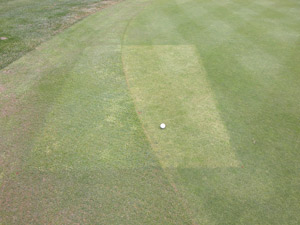On The Road With The USGA - May 2008
Nearly all of the courses visited over the last couple of weeks have confirmed the slow start to the 2008 season. Most courses feel like they're two or three weeks behind what is typical for late May. While the actual conditioning of most courses is in good order given the slow start, there have been a few scattered occurrences of spring aeration not being completed because of wet weather or the work was completed and the wet prevented the complete filling of aeration channels. One of the best ways to draw the ire of golfers is to core aerate and not fill the channels. Timing and having the right tools is clearly an important part of presenting a quality product. It seems like the last time we were experiencing a slow start to the growing season we jumped from cool to hot - keep your guard up.
The playability and maintenance of primary rough has been a discussion topic on a number of recent visits. Despite the slow start to the growing season there has been enough growth to elevate the difficulty of rough. Ideally, avoid lowering the mowing height and instead mow more frequently during times of more aggressive growth. Maintaining the same height all year-round will better guard rough quality through harsh weather, and tightening mowing frequency will help address any playability concern.
 |
|
A number of courses are reporting a higher population of Poa annua this spring. The use of Proxy-Primo to suppress Poa annua seed head growth has become more popular over the last few years to help counter the political and playability impact of seed head growth on putting surfaces. Yet, it is common to hear comments about the Poa annua seeds that are present despite the use of the Proxy-Primo tank mix. While timing is important to achieve full value from the tank mix, some seed growth will still push through. Those courses that have maintained small control plots where no regulation is being added can dramatically illustrate the difference. There is no question that the regulation is helping relative to timing, and there is also no question that control plots can be a very worthwhile tool for future decision making and communication.
Bunker maintenance and playability discussions seem to be unrelenting. This spring the wet weather has clearly exposed poor design, while also making it difficult for the staff to keep up with maintenance needs. Should you rake the bunkers or mow the rough when staff is limited and both can't be accomplished? The answer is - the committee or boss should make the decision. It's the superintendent's job to carry out course maintenance as prioritized by the committee/boss. The prioritization process should be guided by counsel from the superintendent, but the committee/boss should compile the template that the staff will follow. In lieu of needed prioritization, mow the rough and let the hazards be hazards.
If you're seeing anything unique or interesting at your course please let us know. In addition, call or email should there be concerns/questions that we can assist with. If your course hasn't signed up for a visit this year now would be a good time. We look forward to hearing from you.
Source: Bob Brame, bobbrame@usga.org or 859.356.3272
